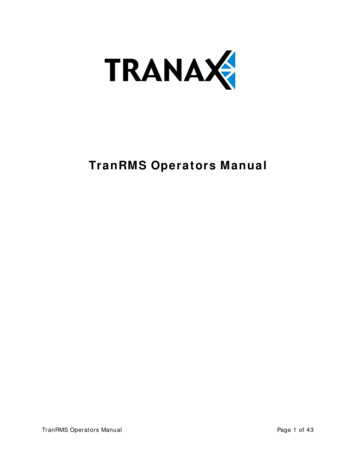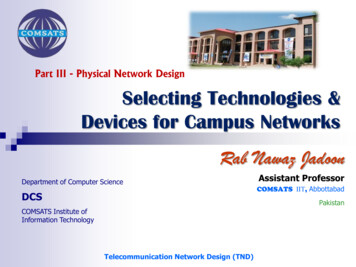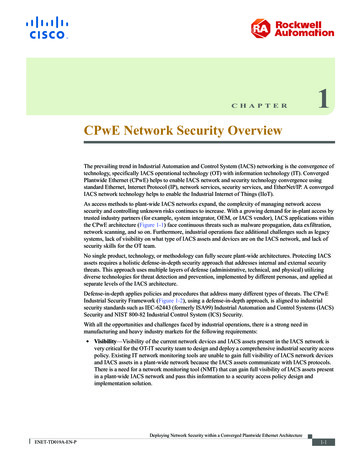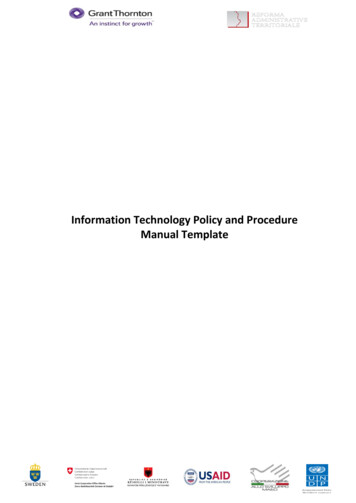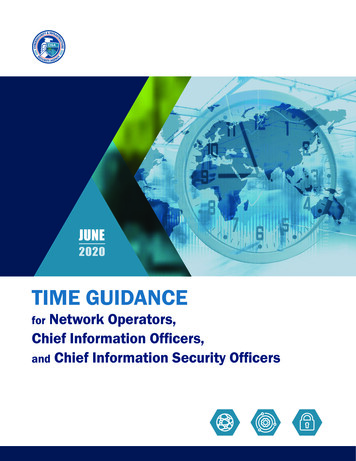
Transcription
JUNETIME GUIDANCENetwork Operators,Chief Information Officers,and Chief Information Security Officersfor
Table of ContentsScope1Background1Introduction2Use Cases3Scenario One3Scenario Two3Scenario Three3Recommendations and Test Plan41. Know Your System42. Know Your Timing Source(s)63. Know Your Users74. Regularly Update Your System85. Document and Test Your System and Sources96. Diversify Your Timing Sources107. Detect and Address Anomalies in Your Timing Sources10Endnotes11References12Appendix A13Glossary14Time Guidance for Network Operators, Chief Information Officers, and Chief Information Security Officers
Time Guidance for Network Operators,Chief Information Officers, andChief Information Security OfficersACCURATE,SYNCHRONIZEDTIME IS CRITICALTO MANY NETWORKFUNCTIONS ANDTO NETWORKSECURITYSCOPEThe Cybersecurity and Infrastructure Security Agency (CISA) developed thisdocument to provide time guidance for network operators, Chief InformationOfficers (CIOs), and Chief Information Security Officers (CISOs). The goal of thisdocument is to inform public and private sector organizations, educationalinstitutions, and government agencies on time resilience and security practicesin enterprise networks and systems. The guidance below attempts to addressgaps in available time testing practices, increasing awareness of time-relatedsystem issues and the linkage between time and cybersecurity.BACKGROUNDEvery network operator must understand time and how it affects theirnetwork(s). Accurate, synchronized time is critical to many network functionsand to network security, yet many users of time services know little about thesource of their time. In the United States, the principal sources of official timeare the Coordinated Universal Time U.S. Naval Observatory, orUTC (USNO), and the Coordinated Universal Time National Institute of Standardsand Technology, or UTC (NIST). See CISA’s additional guidance for C-Suiteexecutives and technical practitioners.1,2U.S. Naval Observatory Master Clock1Time Guidance for Network Operators, Chief Information Officers, and Chief Information Security Officers
INTRODUCTIONThis document aims to provide practical guidance for the management of timein enterprise systems and testing your time resilience. The recommendationsin this document are intended to be incorporated into current test plans andregular systems maintenance. These recommendations can be integratedinto any organization’s master test plan, and are consistent with ExecutiveOrder 13905, Strengthening National Resilience through Responsible Use ofPositioning, Navigation, and Timing Services.Today, nearly all organizations rely on accurate time to sustain their dailynetwork operations. Accurate timestamps are critical for banking and stocktransactions, communications systems, system forensics, audits, andequipment maintenance. The ability of an organization’s time infrastructure todeliver accurate and stable time while protecting the availability and integrity oftime depends on the organization’s function and requirements. Regardless ofwhich timing protocol your organization uses to receive its time—Network TimeProtocol (NTP), Precision Time Portocol (PTP), or via Global Positioning System(GPS)—it is important to know the source of your time and to regularly monitorand test your time systems to ensure they are available andoperating properly.Despite the criticality of accurate and precise time, many organizations do notincorporate time hygiene basics into their routine network maintenance. Whathappens when your network’s timing source is lost? How would you know? Doyou have a documented recovery plan should your network lose valid time?Does your organization conduct regular testing related to time system outagesand recovery to understand critical dependencies? Do you have a documentedprocess for handling leap seconds and Daylight Savings Time adjustments?The last leap second event took place December 31, 2016;3 how did yourorganization prepare for this leap second adjustment and how do your systemshandle leap seconds? See CISA’s Best Practices for Leap Second EventOccurring on 31 December 2016 for additional information.4It is important to know thesource of your time and toregularly monitor and test yourtime systems to ensure they areavailable and operating properly.2Time Guidance for Network Operators, Chief Information Officers, and Chief Information Security Officers
USE CASESThe use cases below exemplify the importance of comprehensive cybersecurity and cyber hygiene practices, andthe correlation of applying these best practices to reduce adverse impacts to your systems’ time. The testingrecommendations listed in this document are intended to help you understand your time requirements and to precludesimilar scenarios from happening to your organization.Scenario One (Actual Event)GPS receiver firmware updates were not applied prior to, and in preparationof, the April 6, 2019, GPS Week Number Rollover event.5 As a result, the NewYork City Wireless Network (NYCWiN), which controls traffic lights and other keyfunctions within the city, was adversely impacted for 11 days in April 2019.A formal report concluded the outage could have been prevented had firmwareupdates been conducted in advance of the rollover event.6,7Scenario Two (Actual Event)As a result of the April 6, 2019, GPS Week Number Rollover, a number ofBoeing Dreamliner aircraft were grounded in China because of a malfunctionwith their GPS equipment. For most airlines, the rollover occurred withoutincident, but older devices onboard some aircraft displayed an almost 20-yeardate discrepancy.8 As many as 15 flights were delayed or canceled as theyawaited GPS software updates.Scenario Three (Real-World Hypothetical)Your IT network has been attacked, causing financial losses and damagingthe reputation of your company. Understanding how the attack took place willassist in preventing future incidents and potentially identifying the attacker.According to Federal Bureau of Investigation (FBI) cyber investigators,timestamps are a crucial artifact when performing digital forensics analysis.When comparing events, it can be difficult to determine what activity causedanother when timestamps are incorrect. When investigating computerintrusions, the timing associated with malware artifacts—being written to diskor in memory—and any corresponding network traffic is critical because it canmake the difference between correlating the network activity of the maliciousattack and introducing ambiguity from other causes. Determination of activityrelated to the user versus a malicious actor is heavily dependent upon theaccuracy and consistency of timestamps across data sets. While timing itself isimportant, it is equally important to understand the time offsets or time zonesof the timestamp data. Only with accurate timestamps and properly correlatedtime offsets can accurate timelines of computer intrusions be retrieved.3Time Guidance for Network Operators, Chief Information Officers, and Chief Information Security Officers
RECOMMENDATIONS AND TEST PLAN1. KNOW YOUR SYSTEMThe best way to manage and secure your network is to understand the nature of all the devices on your network. It isimportant to identify, verify, and document timing dependencies within your organization and create a timing topology(see Appendix A) to assist with identifying the devices that rely on accurate time and the level of accuracy and precisionthe devices need.The following is a real-world instance that demonstrates the importance of knowing your system and keeping it updated.A recent Apple software update notice advised users to update specified devices prior to November 3, 2019, to maintainaccurate GPS location and correct date and time functionality. These devices were not impacted by the April 6, 2019,GPS Week Rollover event as Apple programmed the update to occur on a date after the rollover event. This exemplifieswhy knowing your system is critical to your and your users’ operations; it also directly correlates to item 1.a.3 below.9aManaging timing and synchronization devices used inyour network.TESTING QUESTIONS:1. Do you have policies governing the distribution of time of day onyour network?2. Can you identify which servers provide time across your network? Do you havetraceability from time servers to Stratum 1 clocks? Do those servers acquiretime from a Stratum 1 time reference?3. If a GPS receiver is providing time on your network, are you including thereceiver in your standard IT inventory and providing regular software/firmwareupdates per manufacturer recommendations?4. Do you scan your network regularly for time servers?bIdentify the applications or systems that require time for operationwithin your organization.TESTING QUESTIONS:1. Have you validated that these systems and applications reallyneed time?2. At what level of accuracy, with respect to UTC (NIST)/UTC (USNO), are thesystems reliant on time?3. Do you have a time source and distribution method that meets the level ofaccuracy identified in item 2 above?4Time Guidance for Network Operators, Chief Information Officers, and Chief Information Security Officers
Recommendations and Test Plan (Continued)cMaintain an inventory of your organization’stime-dependent systems.TESTING QUESTIONS:1. Does your organization have an inventory of time-dependent systems andtheir precision requirements?2. Does your organization have an inventory of timing andsynchronization devices?3. Does your organization have a means of keeping this inventory current?4. Is time-reliance documented in your system architecture?dIs your system capable of detecting time anomalies?TESTING QUESTIONS:1. Do you have a published level of service for timing?2. Do you have a way to identify or monitor the level of service (if defined)?3. Are you able to notify your users if your network is not performing to thepublished level of service agreement?4. Is your system capable of detecting anomalies? For example, if your timejumps backwards or forwards?eDo you know how long your system and critical applications canmaintain nominal operation in the absence of synchronization to aprimary time source?TESTING QUESTIONS:1. Has your organization identified a holdover time for each time-reliant systemand application in your inventory?2. Has the holdover time been approved by end users (have you validated that itmeets business or mission requirements)?3. Has regular preventative maintenance been performed to ensure holdoverdevices are operationally ready and maintain quality if the referencesource degrades?5Time Guidance for Network Operators, Chief Information Officers, and Chief Information Security Officers
Recommendations and Test Plan (Continued)fDo you understand how the system reacts when time accuracyis degraded?TESTING QUESTIONS:1. Are systems designed to inform critical, time-dependent applications thattiming is degraded and may not be reliable?2. Do applications have error handling routines to address degraded orunreliable time?3. Are operators trained to respond to GPS receiver alarms/fault indications?4. Do you have an alternate/backup source of timing to go to should yourprimary time source be degraded?2. KNOW YOUR TIMING SOURCE(S)It is imperative to know your primary time source. Do you utilize a time service— NTP, PTP, or GPS—via antennaand receiver? Many organizations utilize a GPS receiver to obtain time and distribute that time through NTP. CISArecommends using at least two or more traceable time sources with the lowest possible stratum to minimize oreliminate timing errors.aIdentify the primary source(s) of time for your organization.TESTING QUESTIONS:1. What is your primary source of time?2. Do you have a secondary time source identified and configured?3. What level of accuracy (i.e., seconds, milliseconds, or microseconds) isprovided by your time source?4. Does that source meet your requirements for time?5. Are processes defined to resolve time source discrepancies?6Time Guidance for Network Operators, Chief Information Officers, and Chief Information Security Officers
Recommendations and Test Plan (Continued)bDo you have a regulatory level of service requirement for yoursystem or application? Determine the level of time performanceneeded for your system or application.TESTING QUESTIONS:1. Can your systems tolerate degradation to level of service?2. Are your systems able to holdover for x hours/days until externaltime returns?3. Are your systems able to operate without your time source for any lengthof time? For example, does the system have a holdover capability (internaloscillator) that enables some level of service during a disruption ofprimary source(s)?cAre all GPS receivers in compliance with the latest GPS InterfaceControl Document (ICD)? The latest version of the GPS ICD can befound on GPS.gov (https://www.gps.gov/technical/icwg/).TESTING QUESTION:1. Have you checked for firmware updates to comply with ICD updates?dDo you have an authentication scheme to verify your time comesfrom a legitimate time server(s)?TESTING QUESTION:1. Have you tested time servers and validated authenticity?3. KNOW YOUR USERSAll network administrators should know their users and their users’ requirements. If they do not know what users need,how can they ensure the systems timing architecture supports their requirements? In most networks, the NetworkTiming Protocol is sufficient, but in others it is not. For instance, some trading houses have a requirement to stamp alltrades within 50 millionths of a second. To fulfill this requirement, timing must be one order of magnitude more accurateto ensure the timestamp never exceeds the threshold. If these same firms trade with the European Union (EU), they willneed to meet the EU’s much more stringent timing requirements. All of this will become more important as businessesadopt distributed ledgers.aDo your users have regulatory requirements for time on their systemor application? Is this captured in your service-level agreement?bDo you know whether your customers depend on your systems/network as a source of accurate time?cHave you published a level of service for timing on your network?7Time Guidance for Network Operators, Chief Information Officers, and Chief Information Security Officers
Recommendations and Test Plan (Continued)4. REGULARLY UPDATE YOUR SYSTEMaPractice good cyber hygiene within your network as well as withspecial-purpose time equipment. Regularly update your systems andfirmware.TESTING QUESTIONS:1. Do you deploy firewalls and use virus protection?2. Are software patches and system updates installed once available?Updates are located at http://www.ntp.org/downloads.html. The networkmanager should maintain a file or log of NTP software/firmware versions ofeach client.3. The NTP Security Notice site can provide vulnerability and mitigation detailsand is located at e.4. Are timing and synchronization devices routinely patched?5. Do you receive push notifications from vendors when patches are available?6. Are GPS timing receivers installed in accordance with Department ofHomeland Security (DHS) best practices?10bWhen incorporating new timing sources or devices, consider fulllifecycle cybersecurity with best practices built-in at the time ofproduct delivery.TESTING QUESTIONS:1. Are timing and synchronization devices included in yourlifecycle management plan?2. If timing and synchronization devices are not upgradeable, are theyscheduled for replacement?3. Does the timing and synchronization equipment have strong defaultsecurity settings?4. Is the timing and synchronization device and its software/firmware adaptableand upgradeable?cFollow guidance provided by the manufacturer for maintenance andupdates to hardware and software to ensure optimal operation ofyour equipment.dRegularly back up data and files (i.e., configuration files,settings, etc.).8Time Guidance for Network Operators, Chief Information Officers, and Chief Information Security Officers
Recommendations and Test Plan (Continued)5. DOCUMENT AND TEST YOUR SYSTEM AND SOURCESaHave processes in place to validate your internal and external timesource(s).TESTING QUESTIONS:1. For timing systems and devices, have you documented processes formaintenance, testing, and validation?2. Do you have time maintenance, time anomaly, and time recovery proceduresdocumented?3. Are these processes incorporated into your standard operating procedures(SOPs)?4. Are employees familiar and trained on timing systems, device maintenance,and testing protocols?5. Do you perform good cyber hygiene?bTest your time equipment to ensure it operates according to youraccuracy and precision requirements.TESTING QUESTIONS:1. Do you have clear timing protocol policies?2. What time servers are master clocks, and how do those clocks acquiretheir time?3. Are GPS/Global Navigation Satellite System (GNSS) timing devices(receivers and antennas) installed and maintained in accordance withDHS best practices?114. Do you have a documented process to establish time after an outage?5. Block non-authenticated ports at the firewall for network perimeter security?cIncorporate battery tests and replacement schedules as part of yourmaintenance schedule. Use an uninterruptable power source (UPS),and test regularly.dUsing a test bed can be helpful prior to deployment of new orupdated systems, but keep in mind there is no guarantee the testbed will operate like the actual network.eTest time intervals annually, and before and after a known timeevent (e.g., leap second, Daylight Saving Time).9Time Guidance for Network Operators, Chief Information Officers, and Chief Information Security Officers
Recommendations and Test Plan (Continued)6. DIVERSIFY YOUR TIMING SOURCESaDiversify receiver types (models and manufacturers) withinyour network; this provides resilience within your network.bUse multiple available timing sources (network-based, system clocks,two-way time transfer, etc.) to avoid single points of failure.cUnderstand the benefits, limitations, and risks associated with eachtiming source.7. DETECT AND ADDRESS ANOMALIES IN YOUR TIMING SOURCESaHave a way to detect anomalies in your time source(s).TESTING QUESTIONS:1. Do you have documented processes to follow should anomalies be detected?These may include audit logs, alerts, etc.2. Are operators/network staff/technical staff trained to respond to alarms thatindicate timing issues?bBased on your time requirements, do you have equipment,processes, and procedures in place to handle extended time sourceoutages and anomalies?cIf your primary time source becomes corrupted or unavailable,do you have a process for moving to an alternative time source?Is this external or internal?10Time Guidance for Network Operators, Chief Information Officers, and Chief Information Security Officers
ENDNOTES1U.S. Department of Homeland Security, Cybersecurity and Infrastructure Security Agency. Fact Sheet on “Time” forC-Suite. ocuments/Corporate Leadership Resilient Timing OverviewCISA Fact Sheet 508C.pdf. Accessed on February 20, 2020.2U.S. Department of Homeland Security, Cybersecurity and Infrastructure Security Agency. Fact Sheet on “Time” forTechnical Practitioners. nts/Technical-Level Resilient TimingOverview-CISA Fact Sheet 508C.pdf. Accessed on February 20, 2020.3Next Leap Second Prediction: Based on current predictions, the next possible leap second date is December 31,2020. However, since the speed of the Earth’s rotation is subject to unpredictable short-term variations, this date maychange. https://www.timeanddate.com/time/leapseconds.html. Accessed on February 20, 2020.4U.S. Department of Homeland Security, National Cybersecurity & Communications Integration Center. Fact Sheet on“Best Practices for Leap Second Event Occurring on 31 December 2016.” nts/Best Practices for Leap Second Event Occurring on 31 December 2016 S508C.pdf. Accessed onFebruary 20, 2020.5Edward Powers. “CGSIC GPS Week Rollover Issue.” U.S. Naval Observatory. September 26, 2017. . Accessed on April 24, 2020.6Colin Wood. “NYC works to reboot wireless network after GPS update crashed it.” StateScoop. April 12, 2019. s-network-after-gps-update-crashed-it/. Accessed on February 20, 2020.7Gartner. “A Report for the City of New York: NYCWiN Incident Assessment.” April 30, 2019. ice-of-the-mayor/nycwin-incident-assessment.pdf. Accessed on February 20, 2020.8Joanna Bailey. “Multiple Boeing 787’s Get Grounded In China Due To GPS Issue.” Simple Flying. April 8, 2019. g/. Accessed on February 20, 2020.9Apple. “Update your iPhone or iPad software if you’re experiencing issues with location, date, and time.” https://support.apple.com/en-us/HT210239. Accessed on February 20, 2020.10U.S. Department of Homeland Security. Fact Sheet on “Best Practices for Improved Robustness of Time andFrequency Sources in Fixed Locations.” January 6, 2015. xed-Locations-508.pdf. Accessed on February 20, 2020.11U.S. Department of Homeland Security, National Cybersecurity & Communications Integration Center. Fact Sheeton “Improving the Operation and Development of Global Positioning System (GPS) Equipment Used by CriticalInfrastructure.” nts/Improving the Operation and Developmentof Global Positioning System %28GPS%29 Equipment Used by Critical Infrastructure S508C.pdf. Accessed onFebruary 20, 2020.11Time Guidance for Network Operators, Chief Information Officers, and Chief Information Security Officers
REFERENCES(1) U.S. Department of Homeland Security, National Cybersecurity & Communications Integration Center. FactSheet on “Improving the Operation and Development of Global Positioning System (GPS) Equipment Used byCritical Infrastructure.” nts/Improving the Operation andDevelopment of Global Positioning System %28GPS%29 Equipment Used by Critical Infrastructure S508C.pdf.Accessed on February 20, 2020.(2) National Coordination Office for Space-Based Positioning, Navigation, and Timing. “Interface ControlDocuments.” November 12, 2019. https://www.gps.gov/technical/icwg/. Accessed on February 20, 2020.(3) U.S. Department of Homeland Security. Fact Sheet on “Best Practices for Improved Robustness of Time andFrequency Sources in Fixed Locations.” January 6, 2015. xed-Locations-508.pdf. Accessed on February 20, 2020.(4) U.S. Department of Homeland Security, National Cybersecurity & Communications Integration Center. FactSheet on “Best Practices for Leap Second Event Occurring on 31 December 2016.” nts/Best Practices for Leap Second Event Occurring on 31 December 2016 S508C.pdf.Accessed on February 20, 2020.(5) Internet Engineering Task Force (IETF). “Network Time Protocol Best Current Practices.” July 2019. pdf. Accessed on February 20, 2020.(6) Executive Order 13905, Strengthening National Resilience through Responsible Use of Positioning,Navigation, and Timing Services, signed February 12, 2020. -timing. Accessed on April 13, 2020.12Time Guidance for Network Operators, Chief Information Officers, and Chief Information Security Officers
APPENDIX ABecause your mission or business service requires accurate time to successfully operate, it is critical to understand andidentify your organization’s time dependencies and requirements. This can best be accomplished by maintaining anawareness of all the devices on your network via network topology diagrams.The network topologies illustrated in figure 1 below provide examples of how your organization can document itstiming dependencies.Notional Time TopologyUTC (NIST)NIST NTP TP Packets)Stratum 1NTP ServerWide AreaNetworkStratum 2NTP ServerMain OfficeEnd UserUTC (USNO) 10-100msUser OfficeLocal NTP ServerTime User/ClientEnd User UTC (NIST)Example Topology 1Example Topology 2Figure 1: Topology ExamplesExample Topology 1 shows GPS and UTC as primary timing sources. The topology shows the timing information fromeither source propagating through the network to an end user device via three devices: a GPS receiver and two NTPservers. All three devices, to include the primary sources, should be documented as time dependencies of theend user device.Example Topology 2 shows a time user/client receiving timing information from NIST.13Time Guidance for Network Operators, Chief Information Officers, and Chief Information Security Officers
GLOSSARYAccuracy – the degree of conformity of a measured or calculated value to its definition, related to the offset from anideal value.*Coordinated Universal Time (UTC) – the international atomic time scale that serves as the basis for timekeeping formost of the world. UTC is a 24-hour timekeeping system. The hours, minutes, and seconds expressed by UTC representthe time-of-day at the Earth’s prime meridian (00 longitude) located near Greenwich, England. UTC is the ultimatestandard for time-of-day, time interval, and frequency measures. Clocks synchronized to UTC display the same hour,minute, and second all over the world (and remain within one second of UT1). Oscillators synchronized to UTC generatesignals that serve as reference standards for time interval and frequency.*Global Positioning System (GPS) – is a U.S.-owned utility that provides users with positioning, navigation, and timing(PNT) services.**GPS Time – the Global Positioning System (GPS) is a constellation of satellites each carrying multiple atomic clocks.The time on each satellite is derived by steering the on-board atomic clocks to the time scale at the GPS Master ControlStation, which is monitored and compared to UTC (USNO). Since GPS time does not adjust for leap seconds, it is aheadof UTC (USNO) by the integer number of leap seconds that have occurred since January 6, 1980, plus or minus a smallnumber of nanoseconds. However, the time offset from UTC is contained in the GPS broadcast message and is usuallyapplied automatically by GPS receivers.***Holdover – performance of an oscillator in the event of loss of synchronization. (Definition developed byPNT Working Group)Leap Second – a second added to Coordinated Universal Time (UTC) to make it agree with astronomical time to within0.9 second. UTC is an atomic time scale, based on the performance of atomic clocks. Astronomical time is based on therotational rate of the Earth. Since atomic clocks are more stable than the rate at which the Earth rotates, leap secondsare needed to keep the two time scales in agreement.*Network Time Protocol (NTP) – a standard protocol used to send a time code over packet-switched networks, such asthe public internet. The Network Time Protocol (NTP) was created at the University of Delaware, and is defined by theRFC-1305 document. The NTP packet includes three 64-bit timestamps and contains the time in UTC seconds sinceJanuary 1, 1900, with a resolution of 233 picoseconds. The NTP format is supported by the NIST InternetTime Service.*NIST Time – UTC (NIST) is the coordinated universal time scale maintained at NIST. The UTC (NIST) time scale comprisesan ensemble of cesium beam and hydrogen maser atomic clocks, which are regularly calibrated by the NIST primaryfrequency standard. The number of clocks in the time scale varies, but is typically around 10. The outputs of the clocksare combined into a single signal by using a weighted average. The most stable clocks are assigned the most weight.The clocks in the UTC (NIST) time scale also contribute to the International Atomic Time (TAI) and Coordinated UniversalTime (UTC). UTC (NIST) serves as a national standard for frequency, time interval, and time-of-day. It is distributedthrough the NIST time and frequency services and continuously compared to the time and frequency standards locatedaround the world.***Oscillator – an electronic device used to generate an oscillating signal. The oscillation is based on a periodic eventthat repeats at a constant rate. The device that controls this event is called a resonator. The resonator needs an energysource so it can sustain oscillation. Taken together, the energy source and resonator form an oscillator. Although manysimple types of oscillators (both mechanical and electronic) exist, the two types of oscillators primary used for time andfrequency measurements are quartz oscillators and atomic oscillators.*Precision – the ability of a device to produce, repeatedly and without adjustments, the same value or result, given thesame input conditions and operating in the same environment.*14Time Guidance for Network Operators, Chief Information Officers, and Chief Information Security Officers
Glossary (continued)Precision Time Protocol (PTP) – a standard protocol defined by the IEEE-1588 standard for sending time over packetswitched networks. The Precision Time Protocol (PTP) can potentially obtain much lower uncertainties than the NetworkTime Protocol (NTP), often less than 1 µs. However, unlike NTP, PTP is generally not implemented over the public internet.Instead, it is typically used over private or local area networks where path del
Time Guidance for Network Operators, Chief Information Officers, and Chief Information Security Officers. 5 6,7 . USE CASES . The use cases below exemplify the importance of com



